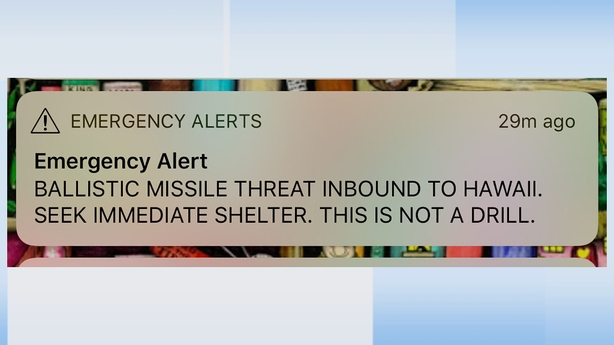Authorities in Hawaii have apologised after an emergency alert was mistakenly sent to people warning them about an incoming ballistic missile.
The emergency alert was sent yesterday to Hawaii's residents warning of an imminent ballistic missile attack when an employee at the state emergency management agency pushed the "wrong button," Hawaii's governor said.
State officials and the US military's Pacific Command confirmed that there was no actual threat to the state. But for more than a half hour, while the agency struggled to retract the warning, panicked Hawaiians scrambled to find shelter.
The mistaken alert stated: "EMERGENCY ALERT BALLISTICMISSILE THREAT INBOUND TO HAWAII. SEEK IMMEDIATE SHELTER. THIS IS NOT A DRILL."
The alert, sent to mobile phones and aired on television and radio shortly after 8am, was issued amid high international tensions over North Korea's development of ballistic nuclear weapons.
Irish woman Claire Cahill, of the Scoliosis Advocacy Network, was having breakfast in #Hawaii yesterday when the false missile alert was issued. She recalls thinking about her three boys at home in Ireland as panic set in. pic.twitter.com/DQItPiJdvl
— RTÉ News (@rtenews) January 14, 2018
Governor David Ige told a news conference he was "angry and disappointed" over the incident, apologised for it and said the state would take steps to ensure it never happens again.
"What happened today was totally unacceptable," the governor said.
Mr Ige said the alert was sent during a employee shift change at the Hawaii Emergency Management Agency, and that the state had no automated process to get out the word that it was a false alarm.
Vern Miyagi, the agency's administrator, called it "human error".
"An employee pushed the wrong button," Mr Ige said.
Mr Ige said the emergency management agency has now ordered a change in its procedures requiring two employees, not just one, to send out such an alert in the future.
In one moment our lives changed completely, yes it was false, yes we’re alive. But this ruined me. My babies are 5 and 2months old they have their whole life ahead of them and here I sat with them in my arms saying sorry I tried to protect you the best I could. #Hawaii
— Destinee Solis (@alohadess) January 13, 2018
Mr Miyagi, who said Hawaii would have only 12 to 13 minutes of warning in an actual attack, declined to say what action would be taken against the employee.
He said the agency routinely tests its emergency alert system and that employee thought he was conducting a test, not realising he had transmitted the warning with a two-step process on a computer screen until receiving it on his own mobile phone minutes later.
"There is a screen that says, 'Are you sure you want to do this?'" Mr Miyagi said, adding that the employee "feels terrible about it".
"This will not happen again," he added.

In November, Hawaii said it would resume monthly statewide testing of Cold War-era nuclear attack warning sirens for the first time in at least a quarter of a century, in preparation for a possible missile strike from North Korea.
The governor said some sirens went off yesterday after the false alarm.
North Korean President Kim Jong-un has threatened to unleash his country's growing missile weapon capability against the US territory of Guam or US states, prompting US President Donald Trump to threaten tough action against Pyongyang, including "fire and fury".
Mr Trump was wrapping up a round of golf in Florida when the incident was unfolding. White House spokeswoman Lindsay Walters said Mr Trump was briefed by aides and that the incident involved "purely a state exercise".
My stomach dropped hearing this on the radio this morning. A feeling of pure terror. #missilethreat #Hawaii pic.twitter.com/VHZjhXxDE1
— Bethany (@bethuhneemartin) January 13, 2018
Stacey Bow, 56, of Honolulu, said that when she received the emergency alert on her phone, she awakened her 16-year-old daughter with the news.
"She became hysterical, crying, you know, just lost it," she said.
Michael Sterling, 56, of Los Angeles, was in Waikiki when he received the alert.
"I was thinking what could we do? There is nothing we can do with a missile," Mr Sterling said.
School administrator Tamara Kong, 43, of Honolulu, said: "Today, the whole state of Hawaii experienced a collective moment of panic and relief."

